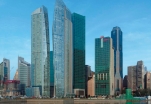From Century to Century: Carrying on the Traditions of Modernism

Peter Pran is often named among the most creative and innovative modern architects. The winner of 15 international and national competitions, and the recipient of over two dozen prestigious professional awards, Pran is working intensively on a range of projects throughout the world. This American architect, who began his professional career working with the great architect Ludwig Mies van der Rohe, remains one of the leading modern developers of the International style, and a true enthusiast of implementing innovative technologies. Norwegian by origin, Pran combined two national traditions into a singular style and became a leading figure in modern architecture. One of his particular interests is high-rise buildings. The architect kindly agreed to discuss this point, as well as a number of other topics, with our correspondent.
You have been working for the renowned firm NBJ for the last fifteen years. What was your career development before NBJ?
The first stage of my professional education transpired in Oslo, Norway. I graduated at the university there with a bachelor degree. After 25 years in Oslo and Scandinavia I moved to the US and I happened to work with one of the great masters of 20th century architecture – Ludwig Mies van der Rohe. It was honor to work with this great master for three years. I took part in the work on such wellknown buildings as the Chicago Federal Center, the Toronto Dominion Centre and the new building of the National Gallery in Berlin.
I was given the opportunity to participate in making key decisions. The next stage in my career was a 7-year period at SOM. For 3 months I took part in the Sears Tower project. The design issues I was engaged within this project defined my future range of interests within modern architecture and influenced the character of my subsequent career. The work on this unique structure turned out to be fascinating and exciting. The next stage of my career after SOM was Ellerbe Becket. I worked for Ellerbe Becket from 1986-1996, and with then NBBJ from 1996 to the present. During my time with NBBJ I designed a 62-storey building in Sydney, which turned out to be a very important experience.
The geographic scope of your work is very wide. It includes structures in the US, Canada, Europe, Asia (Singapore, South Korea, Malaysia), Middle East and South America. Do you have any particular preferences in building typology?
My professional specialization is international high-rise buildings. I feel that high-rises are the result of various engineering technologies developed in the last century, technologies which continue their intensive development through the present day. In my opinion, skyscrapers in a majority of cities need to develop their concept, look and expression in response to the needs of the customer and urban planning demands, as well as the structural and functional needs of the environment, in order to integrate into the existing context. In the largest cities, it makes sense to place high-rises in dense public settings that are transportation centers.
Full version you can download here
 Text by Marianna Maevskaya, photos by Tim Griffith, Byung-Hyun Choi, Christian Richters, NBBJ
Text by Marianna Maevskaya, photos by Tim Griffith, Byung-Hyun Choi, Christian Richters, NBBJ


